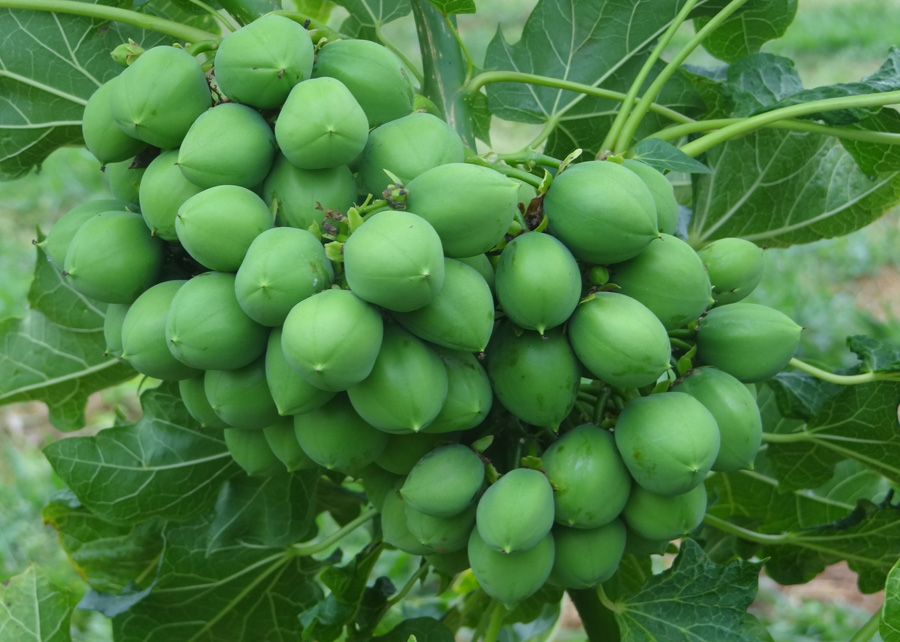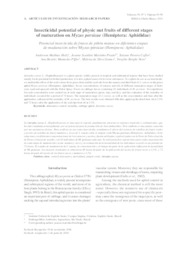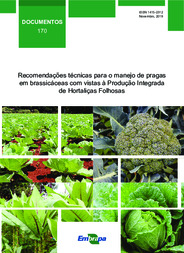Famous for use as biofuel, the plant obtained good results in green peach aphid control. Physic nut has bioactive substances that can be toxic to insects that are agricultural pests. Lab tests showed 75% average mortality rate with the oil extracted from dry fruits. Findings create prospects of developing a future bioproduct for pest control that can reduce or replace the application of agrochemicals. Further studies should perform field tests and study effects of physic nut on other agricultural pests. Jatropha curcas, a species popularly known as physic nut, purgenut or bubblebush, showed considerable potential to control green peach aphid populations (Myzus persicae), in studies performed by Embrapa. The scientists recorded average mortality rates of 75% among such insects with the oil from the seeds of dry fruits. With the oil extracted from ripe fruits, this rate was 68%. The results create prospects for the development of bioproducts that use physic nut as raw material for pest control. The data were obtained 72 hours after in-lab application and the effects were verifiably influenced by the fruit's maturation stage, extract concentration, and length of time after the application. According to the Embrapa Environment researcher Jeanne Scardini Marinho Prado, the plant is widely found in tropical and subtropical regions and has been mostly studied for its potential use to produce biofuels. It is also known for its bioactive substances, which can be toxic to several organisms, including insects. The scientist also explains that the oil is still being tested in laboratory, and other bioassays are required to elucidate the active principles involved in the oil's insecticidal action. The pest The green peach aphid causes damages by sucking sap and introducing toxins into the plant's vascular system. Moreover, it is responsible for virus transmissions and leaf shrinking, which harm plant development. The insect attacks several crops, such as rice, potatoes, cotton, beans, sugarcane, tobacco, citrus, collards and other brassica vegetables. More information on the insect in: Recomendações técnicas sobre manejo de pragas em brassicáceas [Technical recommendations for Brassica pest management] The research Solutions in seven concentrations of extracts and oils from different stages of fruit maturation were sprayed on cabbage leaf disks, and each disk was offered to ten aphid individuals in a Petri dish. “The extract and oil concentrations of 0.0 and 2.0% were the only ones where maturation stage did not influence aphid mortality, in any of the periods assessed”, reports the professor responsible for the research, Anderson Mathias Holtz, from the Federal Institute of Espírito Santo (IFES). Among the methods used to control aphids in agriculture, the chemical one is still the most commonly used. However, the intensive use of such products - especially those that are not recorded for a given pest -could not only select resistant individuals, but also favor the emergence of new pests, since most of those products has broad biological range and high residual power, which can also compromise health of consumers and professionals involved in production. Generally speaking, bioproducts offer lower residual activity and low persistence in the environment. However, before being recommended for use in the fields, the oils still need to be evaluated with regard to such aspects and to their action on not-target organisms. Prado reports that they only perfomed the in-lab assessment of physic nut on aphids, by spraying the solutions on cabbage leaves. The work did not assess any other pest species or perform any field tests. Those are activities for future research. Part of the results were published in the paper "Insecticidal potential of physic nut fruits of different stages of maturation on Myzus persicae", authored by researchers Anderson Mathias Holtz, Jeanne Scardini Marinho Prado, Tatiane Pereira, Ana Mamedes Piffer, Mylena Gomes da Silva, and Vergilio Borghi Neto. Physic nut's potential The paper asserts that the efficacy of physic nut in controlling insects and mites is probably related to the presence of secondary compounds known for their protection against pest attacks. A study quoted by the paper evaluated the capability of a powder made of physic nut seeds and leaves to control the Mexican bean weevil Zabrotes subfasciatus, a pest to stored beans, and observed an insect mortality rate above 90% after 96 hours on bean seeds treated with J. curcas powder at the concentration of 15 g/150 g (powder weight/mass of seeds). Another study included in the discussion observed a high level of alkaloids and tannins, besides a low level of flavonoids, saponins, and phenols, in the physic nut seed powder, which significantly reduced the population of the maize weevil Sitophilus zeamais, a pest to corn, wheat, rice, and several fruits. The insecticidal potential of physic nut oil had also already been observed on Callosobruchus maculatus, an important bean pest known as cowpea weevil, in a different study the paper cites. In addition to being promising to control beetles that attack grains, the oil had also shown exciting results in assessments against the red spider mite, which can attack rubber, cotton, coffee, and fruit trees, among others, with toxicity to eggs and adults, besides repellence and eggs deterrence in a fourth study cited. In general, physic nut seeds are toxic to humans and animals; however, there are studies at Embrapa aimed at detoxifying the meal resulting from extracting the oil from the seeds for use in animal feed. Byproduct of biodiesel production can be bioinsecticide Several studies around the world relate physic nut's toxicity to the level of phorbol esters present in the plant. Phorbol esters could be obtained as co-products in the physic nut biodiesel industry, and showed the effect of reducting the feeding and hindered development of caterpillars in an experiment performed by scientists from Germany and Mexico with the species Spodoptera frugiperda. Considering the fast growth of the biodiesel industry with J. curcas, according to those scientists, large quantities of phorbol esters could be obtained and used in pest control. The oil obtained from dry ripe physic nut fruits showed higher efficiency in comparison with the insecticidal action of unripe fruits when assessed after 72 hours in the highest concentrations; thus, it is possible that with an advanced maturation stage, there is an increase in the amount of toxic compounds responsible for the mortality observed in the Mysus persicae population. Other studies reported that the age and development of the plant and its diverse organs are important and can influence the total quantity of metabolites produced, and the relative proportion of the solution components. Thus, there may be differences in the quality and quantity of toxic compounds, such as the phorbol esters present in dried, ripe, and green fruits.
Photo: Bruno Laviola
![Bruno Laviola - Physic nut is widely found in tropical and subtropical regions Bruno Laviola - Physic nut is widely found in tropical and subtropical regions]()
Physic nut is widely found in tropical and subtropical regions
-
Famous for use as biofuel, the plant obtained good results in green peach aphid control. -
Physic nut has bioactive substances that can be toxic to insects that are agricultural pests. -
Lab tests showed 75% average mortality rate with the oil extracted from dry fruits. -
Findings create prospects of developing a future bioproduct for pest control that can reduce or replace the application of agrochemicals. -
Further studies should perform field tests and study effects of physic nut on other agricultural pests. |
Jatropha curcas, a species popularly known as physic nut, purgenut or bubblebush, showed considerable potential to control green peach aphid populations (Myzus persicae),
in studies performed by Embrapa. The scientists recorded average mortality rates of 75% among such insects with the oil from the seeds of dry fruits. With the oil extracted from ripe fruits, this rate was 68%.
The results create prospects for the development of bioproducts that use physic nut as raw material for pest control. The data were obtained 72 hours after in-lab application and the effects were verifiably influenced by the fruit's maturation stage, extract concentration, and length of time after the application.
According to the Embrapa Environment researcher Jeanne Scardini Marinho Prado, the plant is widely found in tropical and subtropical regions and has been mostly studied for its potential use to produce biofuels. It is also known for its bioactive substances, which can be toxic to several organisms, including insects.
The scientist also explains that the oil is still being tested in laboratory, and other bioassays are required to elucidate the active principles involved in the oil's insecticidal action.
The pest The green peach aphid causes damages by sucking sap and introducing toxins into the plant's vascular system. Moreover, it is responsible for virus transmissions and leaf shrinking, which harm plant development. The insect attacks several crops, such as rice, potatoes, cotton, beans, sugarcane, tobacco, citrus, collards and other brassica vegetables. More information on the insect in: Recomendações técnicas sobre manejo de pragas em brassicáceas [Technical recommendations for Brassica pest management] |
The research
Solutions in seven concentrations of extracts and oils from different stages of fruit maturation were sprayed on cabbage leaf disks, and each disk was offered to ten aphid individuals in a Petri dish.
“The extract and oil concentrations of 0.0 and 2.0% were the only ones where maturation stage did not influence aphid mortality, in any of the periods assessed”, reports the professor responsible for the research, Anderson Mathias Holtz, from the Federal Institute of Espírito Santo (IFES).
Among the methods used to control aphids in agriculture, the chemical one is still the most commonly used. However, the intensive use of such products - especially those that are not recorded for a given pest -could not only select resistant individuals, but also favor the emergence of new pests, since most of those products has broad biological range and high residual power, which can also compromise health of consumers and professionals involved in production.
Generally speaking, bioproducts offer lower residual activity and low persistence in the environment. However, before being recommended for use in the fields, the oils still need to be evaluated with regard to such aspects and to their action on not-target organisms.
Prado reports that they only perfomed the in-lab assessment of physic nut on aphids, by spraying the solutions on cabbage leaves. The work did not assess any other pest species or perform any field tests. Those are activities for future research.
Part of the results were published in the paper "Insecticidal potential of physic nut fruits of different stages of maturation on Myzus persicae", authored by researchers Anderson Mathias Holtz, Jeanne Scardini Marinho Prado, Tatiane Pereira, Ana Mamedes Piffer, Mylena Gomes da Silva, and Vergilio Borghi Neto.
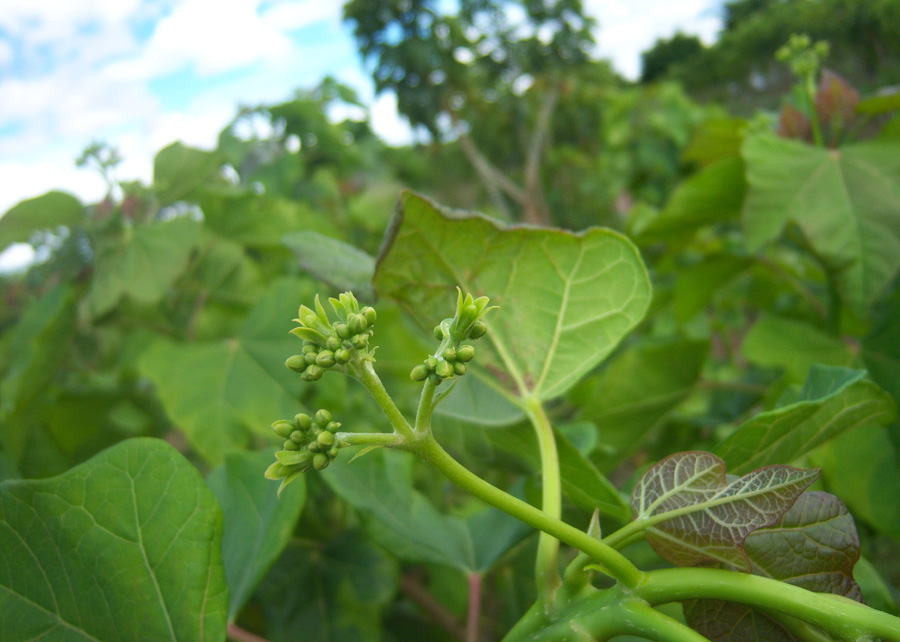 Physic nut's potential Physic nut's potential
The paper asserts that the efficacy of physic nut in controlling insects and mites is probably related to the presence of secondary compounds known for their protection against pest attacks. A study quoted by the paper evaluated the capability of a powder made of physic nut seeds and leaves to control the Mexican bean weevil Zabrotes subfasciatus, a pest to stored beans, and observed an insect mortality rate above 90% after 96 hours on bean seeds treated with J. curcas powder at the concentration of 15 g/150 g (powder weight/mass of seeds). Another study included in the discussion observed a high level of alkaloids and tannins, besides a low level of flavonoids, saponins, and phenols, in the physic nut seed powder, which significantly reduced the population of the maize weevil Sitophilus zeamais, a pest to corn, wheat, rice, and several fruits. The insecticidal potential of physic nut oil had also already been observed on Callosobruchus maculatus, an important bean pest known as cowpea weevil, in a different study the paper cites. In addition to being promising to control beetles that attack grains, the oil had also shown exciting results in assessments against the red spider mite, which can attack rubber, cotton, coffee, and fruit trees, among others, with toxicity to eggs and adults, besides repellence and eggs deterrence in a fourth study cited. In general, physic nut seeds are toxic to humans and animals; however, there are studies at Embrapa aimed at detoxifying the meal resulting from extracting the oil from the seeds for use in animal feed. 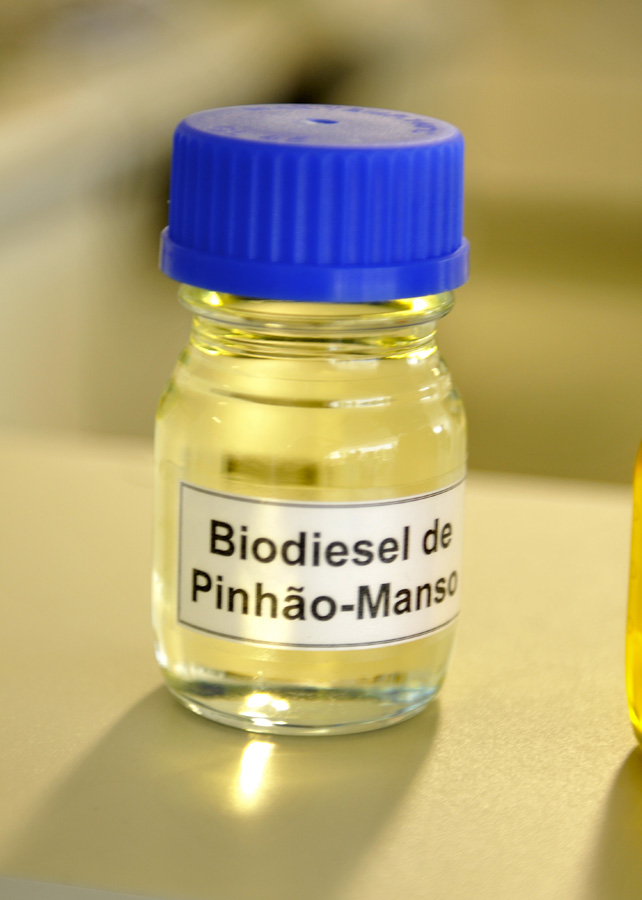 Byproduct of biodiesel production can be bioinsecticide Byproduct of biodiesel production can be bioinsecticide
Several studies around the world relate physic nut's toxicity to the level of phorbol esters present in the plant. Phorbol esters could be obtained as co-products in the physic nut biodiesel industry, and showed the effect of reducting the feeding and hindered development of caterpillars in an experiment performed by scientists from Germany and Mexico with the species Spodoptera frugiperda. Considering the fast growth of the biodiesel industry with J. curcas, according to those scientists, large quantities of phorbol esters could be obtained and used in pest control. |
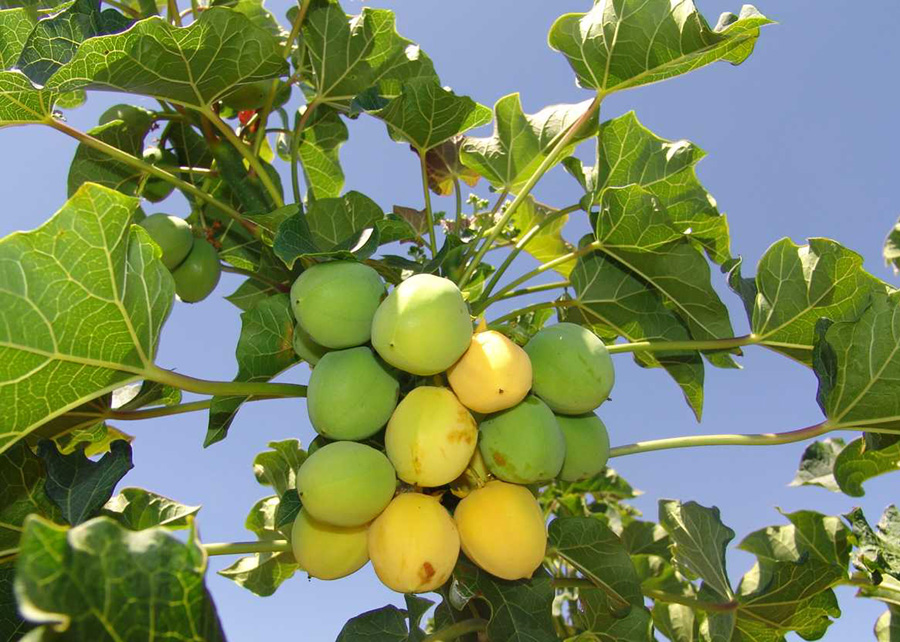
The oil obtained from dry ripe physic nut fruits showed higher efficiency in comparison with the insecticidal action of unripe fruits when assessed after 72 hours in the highest concentrations; thus, it is possible that with an advanced maturation stage, there is an increase in the amount of toxic compounds responsible for the mortality observed in the Mysus persicae population.
Other studies reported that the age and development of the plant and its diverse organs are important and can influence the total quantity of metabolites produced, and the relative proportion of the solution components. Thus, there may be differences in the quality and quantity of toxic compounds, such as the phorbol esters present in dried, ripe, and green fruits.
Cristina Tordin (MTb 28.499/SP)
Embrapa Environment
Press inquiries
Phone number: +55 19 3311 2608
Translation: Mariana Medeiros (13044/DF)
General Secretariat
Further information on the topic
Citizen Attention Service (SAC)
www.embrapa.br/contact-us/sac/

